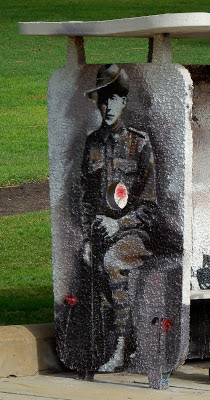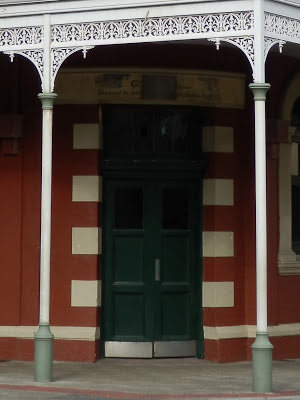Fremantle is not my home.
I don't know it like the back of my hand.
Not like my mother does and my grandfather does. Granddad moved here 60 years ago and never left, Mum was born and bred here and it took her 20 odd years before she left.
As I was growing up, I knew of Fremantle as two separate places joined disjointedly somewhere in the middle. It had one side, where the markets and Kakulas are, another entered from the Canning Hwy side, which ended with the Woolstores and Clancy's. Oh, and then there was the old Maritime Museum, stuck somewhere on the edge near the Round House and an old jetty.
It wasn't until I started working there that my disjointed memories slotted together like jigsaw pieces and gave me a better understanding of Fremantle as a whole. But it was still a limited view. I saw the main streets the bus travelled down, or the route we took to travel between the two sides of the town. But I only got tantalising glimpses of the old ornate buildings hiding down the side streets.
Even now, I still get distracted by the pretty buildings that appear out of nowhere and could rapidly lose myself in the maze that still is Fremantle's streets. In an attempt to overcome this, and because I had some architectural research I wanted to do, I left the house I'm sitting, on a proper bike and headed into Freo, on the most scenic, least up-hill route I could think of.
Fremantle played a huge part in the World Wars, being one of the ports through which ships of soldiers and supplies left to play their part. The efforts of these soldiers, and the families during their bit on the home front is remembered at Monument Hill, a monument on a hill, overlooking Fremantle and her harbour.
I don't know it like the back of my hand.
Not like my mother does and my grandfather does. Granddad moved here 60 years ago and never left, Mum was born and bred here and it took her 20 odd years before she left.
As I was growing up, I knew of Fremantle as two separate places joined disjointedly somewhere in the middle. It had one side, where the markets and Kakulas are, another entered from the Canning Hwy side, which ended with the Woolstores and Clancy's. Oh, and then there was the old Maritime Museum, stuck somewhere on the edge near the Round House and an old jetty.
It wasn't until I started working there that my disjointed memories slotted together like jigsaw pieces and gave me a better understanding of Fremantle as a whole. But it was still a limited view. I saw the main streets the bus travelled down, or the route we took to travel between the two sides of the town. But I only got tantalising glimpses of the old ornate buildings hiding down the side streets.
Even now, I still get distracted by the pretty buildings that appear out of nowhere and could rapidly lose myself in the maze that still is Fremantle's streets. In an attempt to overcome this, and because I had some architectural research I wanted to do, I left the house I'm sitting, on a proper bike and headed into Freo, on the most scenic, least up-hill route I could think of.
Climbing up for the view, I had to wonder, what had been there before. After all, Fremantle was founded in 1829 and the surrounding area was filling up with houses as the Federation was being celebrated, 18 years before the war ended and fallen soldiers deserved commemorating.
| One of the beautiful old houses at the bottom of the hill. Unfortunately, one that it is nigh impossible to get in to despite it being a museum. |
Old Maps tell me it was an obelisk, which seems pretty unbelievable until you remember we are standing in a British colony and they seemed to have a penchant for Obelisks. I doubt if it was an important one, but then again, it could be sitting in storage at the museum.
While the view was impressive, what was more beautiful was the graffiti on the bus stop at the bottom of the hill. Beautifully rendered, it was a more poignant reminded of the lives lost that the monument above, because it gave it a face, and because of the poppies that remind me of John McCrae's poem that would be read every year at school on Remembrance day.

In Flanders fields the poppies blow
Between the crosses, row on row,
That mark our place; and in the sky
The larks, still bravely singing, fly
Scarce heard amid the guns below.
We are the Dead. Short days ago
We lived, felt dawn, saw sunset glow,
Loved and were loved, and now we lie
In Flanders fields.
Take up our quarrel with the foe:
To you from failing hands we throw
The torch; be yours to hold it high.
If ye break faith with us who die
We shall not sleep, though poppies grow
In Flanders fields.

In Flanders fields the poppies blow
Between the crosses, row on row,
That mark our place; and in the sky
The larks, still bravely singing, fly
Scarce heard amid the guns below.
We are the Dead. Short days ago
We lived, felt dawn, saw sunset glow,
Loved and were loved, and now we lie
In Flanders fields.
Take up our quarrel with the foe:
To you from failing hands we throw
The torch; be yours to hold it high.
If ye break faith with us who die
We shall not sleep, though poppies grow
In Flanders fields.
What I love most about the photo above, is not that it incorporates the bus stop and the monument on the hill above, but that the little old lady sitting at the bus stop is very likely of Eastern European descent and was part of the waves of immigrants who arrived in Fremantle after the second world war. What stories does she hold of her first few years in this port city? Did she arrive as a school girl and find herself immediately inserted into a local school where everyone spoke a language she didn't understand? What did she expect to find here when she did arrive? Was the reality anything like her expectations? How difficult was it adjusting from the food and culture and lifestyle she was used to? My own family were shocked on their arrival in 1952 to find that the daily necessity that is coffee had yet to arrive in this outpost. Instead, a family used to frequent Turkish coffees was expected to survive on coffee essence, a compound made of chicory and tasting nothing like the real stuff.
 |
| 'Coffee Palace' was actually used to indicate alcohol-free hotels, built in response to the temperance movement. |
Heading back into the centre of Fremantle from here it made sense to take Adelaide St where I knew there was an old church and an old house which I vaguely remember my mother telling me had a less than rosy past. However when I got there, what was of more intrigue was the proclamation Moreton Bay Fig planted in the middle of the road, and the giant Celtic cross beside it.
Why had I never noticed these before? Why was October 21 1890 not a date I knew, the granting of a responsible government to the colony of Western Australia? Who exactly was the man who gave his name to Marmion St?
Turning west toward Kakulas Sister I stocked up before going in search of the site of Manning's Folly, an extravagant construction of glass built in the middle of the 19th century, but demolished in 1928. Wandering through the streets west of Market street you begin to stumble upon a multitude of hotels, all festooned with the typical Edwardian balconies and decorative façade and now either containing shops and offices or remaining the watering holes they always were.
They all date from the turn of the century when Fremantle was one of the international gateways to this colony, before air travel, before a small tin shed began to transform into the International Airport as we know it today. Imagined in their heyday, they are an impressive, welcoming sight to behold upon arrival in this distant place.
On this occasion, its the little details I look for and revel in, the detailing which reminds me of traipsing around London, eyes pointed skywards; the little gargoyle sitting on the Central Chambers, the fine lettering above the door of the P&O Hotel.

Knowing the coast was nearby I turned my bike westwards still further in search of the rippling line in the pavement that delineated the original coastline and the extent of land that even here European settlers had claimed back from the sea.
I can understand big, old cities like London reclaiming land from the river, but architecturally, Perth was a new colony. Surely there was enough land already without the need to claim more from the sea. What was the reason behind this different coastline? Was it an aesthetic desire to straighten the coastline as they did the Swan River? Was it simply a repercussion of deepening the harbour?
Fremantle is still not home to me, but it's nice to feel I've taken the time to make its acquaintance properly and to feel there's still more I want to learn about this beautiful port town.


Howdy,
ReplyDeleteI don't know how many prominent Marmions there were in colonial WA (or in Fremantle), but I do know that one Patrick Marmion, Master Whaler, established a whaling station further up the coast. There's a dingy, unassuming monument commemorating this fact in a little park in Sorrento, just down the hill from where I went to secondary school. Clearly, Marmion Avenue, which runs right through the area and beyond, takes his name.
You mentioned imagining the buildings west of Market Street in their heyday. Seeing as you made it as far as the Roundhouse, did you see the black-and-white mural street photograph? I think the image dates from about 1920 or something.
"Fremantle as international gateway..." There's a scene in The Twyborn Affair in which Eddie Twyborn steps off the boat in Fremantle Harbour on a scorching hot day, and walks into a pub. The person behind the bar, who is used to visitors and immigrants stopping in, asks him where he's from. Eddie simply answers, "From here." I know White passed through Fremantle at one point - he might have been returning to New South Wales after the end of WW2. He even writes an account of it somewhere, perhaps in Flaws in the Glass. It's his "I am the stranger of all time" piece. But he possibly also had a similar experience to the event he fictionalised.
Thanks Glen.
DeleteI don't remember noticing the mural but then on this occasion I was focused on the architecture above me. Will have to keep my eyes open for it next time.
I enjoyed White's Fringe of Leaves, so I'll have to check out The Twyborn Affair and Flaws in the Glass.